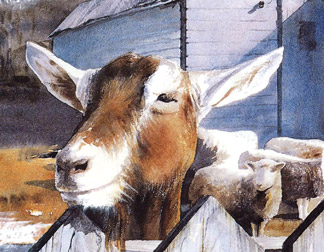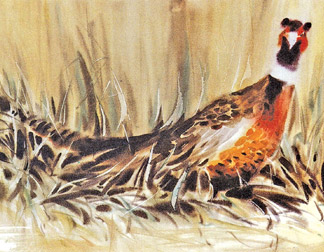Learning to simplify

To be able to draw any complicated texture such as fur and feathers
of birds or animals, you must be able to simplify the subject to some
extent, which is less easy than it sounds. I asked a few painters how
they went about the process, and got a bewildering set of replies. “I
just look”, said one, “and I look again”. Not finding this helpful, I
asked another artist how one specialized in wildlife painting.
“You learnt it over a lifetime’s experience,” he said, and then he
added somewhat conspiratorially, “I have my method”. This shows more
than anything else that there is no particular recipe - artists don’t
always know exactly how they do things.
However, over the years I have found some of the following methods
helpful. First consider the concept of the painting - what it is that
you want to paint and why. This may seem rather obvious, but it is
sometimes easy to forget once you get involved in the painting.
|
Tips
*Keep a reference file photographs and drawings of animals and birds
is an invaluable aid for any artist. These can be obtained from
magazines and newspapers and get into the habit of looking at printed
matter with possible composition and subject matter in mind
*Devise some simple system of cataloguing, so that you can find
information quickly when you need it. For example, you may have sections
on farm animals, exotic birds, breed of dogs and so on
* Never throw away experiments with different media and techniques,
as these can be useful for future work |
 |
|
Here wet-in-wet washes are combined
with dry-brush work to convey a convincing impression of the
goat’s head |
If you want to paint a portrait of your cat or dog, for example it
would be distracting to get too involved in some detail in the
background. Keep the focus on the way the light is reflected from the
fur or the special markings and make sure all the other parts of the
composition are supporting this central idea.
Even when you know what you want to paint and have got a reasonably
clear focus, live subjects present you with so much visual information
that you have to leave some of it out.
The problem is, of course, what to leave out. Try looking at the
animal or bird and study and remember as much as you can. Then quickly
put down as much information as you can remember.
Media and methods
To paint a perfectly good portrait or still life, special emphasis on
texture is a paramount importance. A drawing or painting of a bird or
animal without any indication of the characteristics of its fur, wool or
feathers would be largely meaningless. Media and methods provide some
ideas on how to tackle the purely technical aspects of the subject, but
unfortunately technique is not the only problem the artist has to cope
with.
Watercolour is an ideal sketching medium because it is so responsive
and can be used with such rapidity, but it is also ideal for more
detailed studies. Most of the great bird and animal artists of the 19th
Century used watercolour to record every detail of their subjects with
extraordinary precision. A technique used by many artists to convey the
effect of fur and feathers is dry brush.
This is a method of painting with the minimum of paint on the brush
so that the colour only partially covers the paper, resulting in a
rather broken rasping texture. You need to practise to get the
consistency of the paint right.
Dry brush is extremely effective when used in conjunction with thin
washes of watercolour. The dry application of the paint is wonderful for
capturing the soft and powdery lighting effects of some furs.
A related method is dry brush, which can be very useful as a final
layer. In this method, similar to that described under watercolour,
small amounts of thick colour are applied to existing dry layers of
paint in a light skimming action to produce rather broken texture in
which the underlying layers of paint strike through. It is particularly
useful for modifying areas of the painting and for establishing the
drier and more diffuse highlights that you might find with thicker fur
or massed feathers.
It takes some practice to be able to make sketches that contain
enough information to use as a basis for painting, so for a beginner it
is good idea to start off by drawing some creature that will remain
still for long periods of time. Horses in a field, or goats, deer in a
park, cows in grassland, all make good subjects, and offer a wide range
of different textures.
 |
|
This is a fine example of how
effectively wet-in-wet watercolour technique can be used to
suggest the soft textures of feathers. The effect is
enhanced by the contrasting sharp lines of grass, achieved
by scaping back into the wet washes |
Observation is as important as sketching, and here binoculars are a
valuable aid, as you can focus in more closely on the subject. For those
who are interested to draw more exotic animals such as bears, leopards,
lion, the zoo is the obvious place to visit. This is also the best
possible place for sketching birds such as parrots and birds of prey.
Your subjects will of course, move, but at least, being caged, they
will not disappear. Although these rough sketches are essential practice
and can help give a lifelike feeling to the drawing or painting, you
will almost certainly need more detailed information as well, and here
the photograph comes into its own.
Photographs
A wildlife artist see them as a supplement to their other studies,
and indispensable when it comes to drawing and painting the smaller or
rarer animals and birds. However, photographs do have to be used with
caution.
Although a good photograph will present a very realistic and detailed
image of the subject it doesn’t simplify the problems, because it
provides you with too much information giving you the job of deciding
what to concentrate on and what to leave out.
Without some other source such as a sketch it can be difficult to
make such decisions. It is always best to keep a little distance between
the photograph and the painting so that it is used as a reference and
does not become the subject of the painting. After all, it is only an
image of a bird or animal, not the real life creature.
www.tisshewavitarana.com
|



